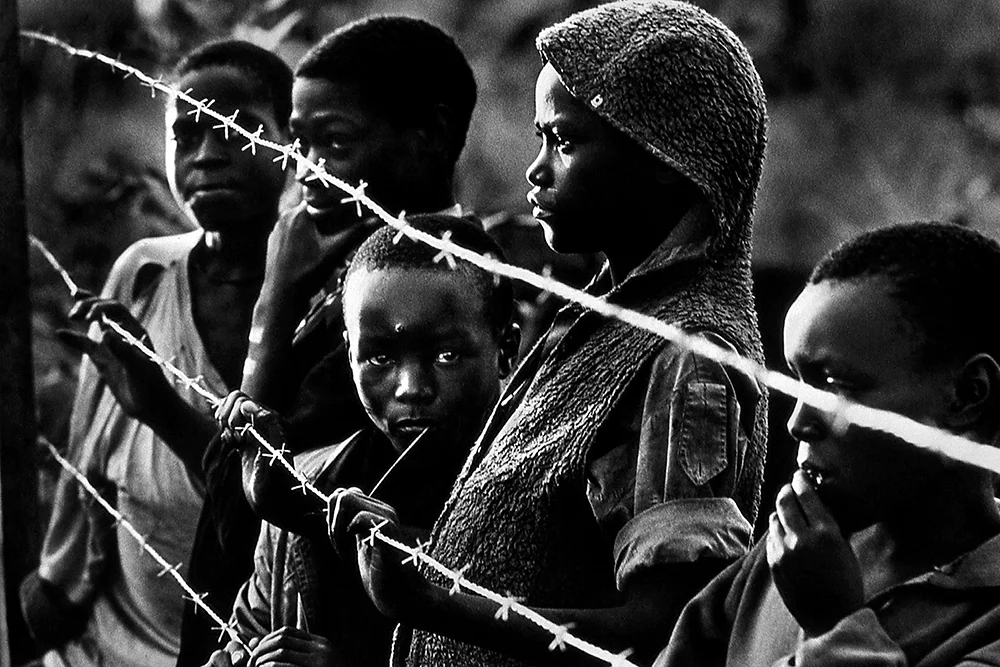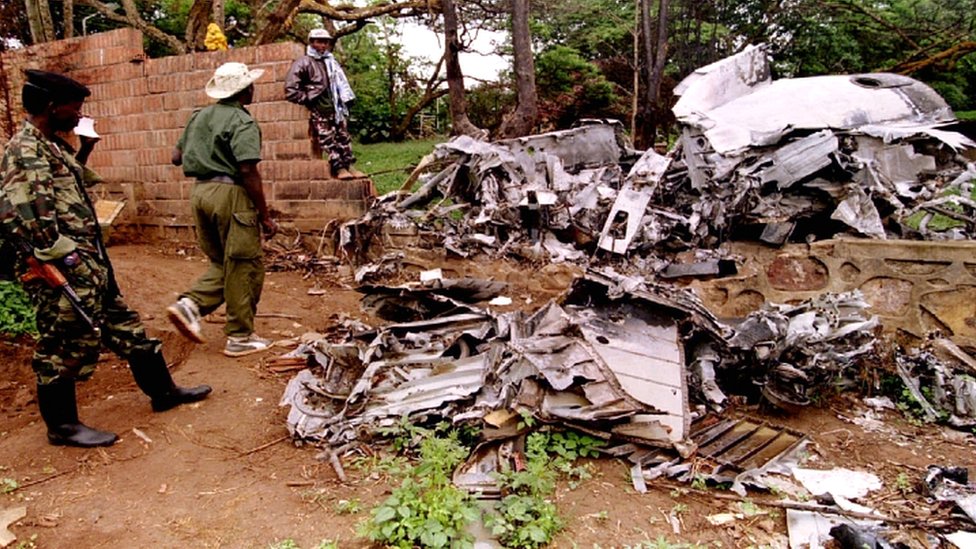
It was the year 1994, when within a duration of 100 days, 10 lakh people from one particular community were massacred brutally. Well…the genocide didn’t take place just like that, all of a sudden, it was a result of immense and targetted hate brewing in the society, fuelled by the leaders and propagated by the media to so much of an extent, that people didn’t even think twice before killing their neighbours, spouses and small children. This is the story of ‘Rwanda Genocide’, which I will be unravelling in my blog.
A Brief History of Rwanda
The initial residents of Rwanda were hunter-gatherers who settled in the area around 500 BC. Slowly the tribes called Bantu groups came into the region and began creating shelter by clearing forests. With time, two distinct groups emerged, Hutus and Tutsis. The former formed the majority with close to 85% share in the population, and the Tutsis were minorities. The two communities shared the same language and culture, and are mostly of the Christian religion. Together, they are also known as Banyarwanda.
Notably, the distinction was not racial but class-based. While the Hutus were farmers, the Tutsis were cattle herders. Since cattle herding was more beneficial monetarily, the Tutsis with time got more prosperous than the Hutus. Although Hutus were the overwhelming majority, the Tutsis were the ones who held power in the country historically. The Tutsi Nyiginya clan ruled the whole Kingdom of Rwanda, through conquest and assimilation. The most prominent ruler of the kingdom was King Kigeli Rwabugiri.
Making of the Genocide
Slowly, the cracks started emerging because of the policies of the Tutsi rulers. Especially, after the European countries reached Rwanda during their conquest, the situation further worsened. After the Berlin Conference of 1884, Rwanda along with Burundi was assigned to Germany, which started ruling the country through the monarchy. For exerting their power, the colonists favoured Tutsis as they considered them “racially superior”. The Tutsi rulers too welcomed the colonists warmly, as they were able to bear sweeter fruits of power. The control of Rwanda (and Burundi) came under Belgium during WWI. Further, after WWII, the stand of the colonists changed and they started transferring the power to the Hutus.
A Hutu emancipation movement began fuelled by resentment by the community. Quite interestingly, the Catholic churches too skewed their sympathy towards the Hutus. The churches led a rapid formation of sizeable Hutu clergy and educated class to provide a counterbalance to the established political order. Sensing danger, the Tutsis too tried to agitate, which led to a series of agitation and killings. But this time, it was the Hutus who had the backing of colonists (Belgium), and as a result, all the Tutsis chiefs were replaced by Hutus. The mid-year elections further transferred the power to the majority community of Hutus. Finally, in 1959, the monarchy was overthrown, the king was deposed, and Rwanda became an independent republic in 1962. It was followed by thousands of Tutsis fleeing into the neighbouring countries including Uganda, and remaining in exile for the next three decades.

The Tutsis honouring the massacred victims (Photo: The Washington Post)
The Rise of the RPF
In the 1980s, the Tutsi refugees in Uganda supported by some moderate Hutus formed Rwandan Patriotic Front (RPF) led by Paul Kagame (current President). It was formed after the Hutu migrants were able to assist in a coup in Uganda, where Yoweri Museveni overthrew Milton Obete. The RPF was now aiming to overthrow the Hutu President Juvenal Habyarinama, secure the right to return homeland and reestablish a Tutsi-led rule in Rwanda.
Subsequently, the RPF invaded Rwanda through a series of 4000 rebels and a covert network of tanks. After a series of attacks and negotiations, a peace accord was signed between the then President, Juvénal Habyarimana and the RPF. However, it did little to stop the unrest. Finally, in 1993, peace negotiations seriously resumed in Arusha, and the subsequent accords are called as Arusha Accords. However, things were not going to be as smooth. The Hutu power, led by extremists had already begun compiling a list of “traitors”, who they planned to kill. Many believe, that Rwandan President Habyarinama’s name was also on the list. The extremists considered him a traitor as he was working towards establishing peace.

The plane carrying Rwandan President suffered a mysterious crash (Photo: BBC)
D-DAY
Then came the D-Day. On April 6, 1994, a plane carrying the Rwandan President and his Burundian counterpart, was shot down, killing everyone on board. Although the real culprit behind the attack is still a mystery, the Hutu community had already made up their mind that it is RPF who is behind this. While, on the other side, it is also alleged that the Hutu extremists themselves killed the President to get away with their “traitor” and get an open-and-shut opportunity to launch a massacre against the Tutsis. The second theory was also pointed out by Belgium after their investigation years later. Following Habrynama’s death, PM Agathe Uwilingiyamana was legally next in line for the post, but she too was declined and killed later. The power now came directly under the military. This turned out to be the ‘ticking point’ in the dark episode.
The Genocide begins
Within hours, a series of slaughters started from the capital Kigali, to throughout the country targeting the Tutsis. People were being killed with machetes and saws. Several women were abducted and kept as sex slaves. Since at that time, the ID cards carried by people also mentioned their identity (Hutu or Tutsi), it was easy for the officials who had already barricaded the city, to identify whom to kill. The churches too played an active role in the genocide. Many people were locked inside the churches and burned alive. Some priests of the churches raped Tutsi women and ran bulldozers over churches where Tutsis were hiding. The severity of the hate campaign was so high that neighbours were killing the neighbours, and if that wasn’t enough, Hutu husbands were killing their Tutsi wives…yes you read that right.
There was complete cooperation from the government in the killing. A meticulous piece of planning was done behind the slaughter. The government gave a list of ‘political opponents’ to the militias and instructed them to kill them along with their families. Machetes, razor blades, saws and scissors, were imported at much larger than normal scale and were subsequently distributed among the normal citizens as part of the civil defence network. Right from the centre to districts to villages, the message was clear…all the Tutsis have to be killed. The ruling party MRND had a youth wing called Interhamwe. They actively participated in the slaughter in the form of ‘militants’. Weapons were handed over to the militias, who knew exactly where their target was. The police and security officials simply didn’t intervene saying “We don’t have any orders” (2002 vibes).

Visual of Tutsi corpses after the genocide (Photo: The Washington Post)
How did the Genocide end?
On one side the violence was at its peak. On the other side, a well-organised RPF also started the counter-attack and slowly started gaining territories with the help of the Ugandan Army. On July 4, 1994, the RPF reached the Rwandan capital of Kigali. Looking at this, around 2 million Hutus, fearing revenge attacks fled the country, mainly into Congo (called Zaire then), Burundi and Tanzania. On July 18, RPF declared a ceasefire and said that the war is over. Pastor Bizimungu was declared the President. However, the RPF too were no angles. After returning to power they too killed thousands of Hutu civilians and the series of revenge continued.
The violence went on for three months. The number of victims in the genocide is estimated at over 10 lakhs. Around 3 lakh Tutsis survived the genocide. Over 5 lakh women were raped during the genocide, leaving many of them HIV-positive for life. Over 4 lakh children were left as orphans after this episode. More than 1.2 million people were tried for their role in the genocide, and dozens of senior Hutu officials were convicted at the UN tribunal in neighbouring Tanzania.
Role of Media and Propaganda
In sensitive matters, propaganda always plays a huge role, and so was the case here. The Hutu extremists set up radio stations, and newspapers, and perfectly used them to carry out extremism and hate propaganda. The Radio Television Libre des Mille Collins (RTLMC), also known as Radio Rwanda took propaganda to next level, by broadcasting racist and hateful content, obscene jokes and music, and literally calling out people to kill. A popular line propagated was “Weed out the cockroaches”, which meant ‘Kill the Tutsis’ and “The Graves are not yet full”.

‘Radio Rwanda’, other media platforms played huge role in propagating hate (Photo: The Mail and the Guardian)
The Failure of Big Powers
This episode is also considered a huge failure for the international community and the so-called superpowers. The UN forces were in Rwanda at the time, this genocide happened. The UN force commander there even sent a letter to the UN headquarters, where he warned of the Hutus hatching a plan to exterminate the Tutsis. But, the head of UN Peacekeeping, Kofi Annan, failed to act on the suggestions. Belgium is especially blamed for worsening the atmosphere for personal gains, and doing ‘nothing’ to manage the situation.
France, at that time, was an ally of the Hutu-led government. It did send its forces to evacuate its own citizens but did nothing to stop the violence. Paul Kagama (current president) even accused French forces of helping those carrying out the massacres, as they were allies of Hutus. However, France has denied the allegation till today. The US, on the other hand, didn’t want to enter another controversial fight in Africa, because of the Battle of Mogadishu (Somalia) a year earlier, where 18 US soldiers were killed. However, it did send some of its forces, but only to evacuate ‘white American people’.

Visual of corpses after the Rwandan genocide (Photo: CNN)
Aftermath of violence
Today, Rwanda has come a long way from its dark episode. The current president, Paul Kagame is hailed for the economic progress and technological development in the country. However, at the same time, he is also accused of crushing any form of dissent establishing an ‘almost dictatorship’. Several unexplained deaths of political opponents further give more fuel to those allegations. Today, it is a crime to even talk about ethnicity in Rwanda. While some call the status the right way to prevent any more racist attacks, many are of the opinion, that it is just a covering for the cracks that remain in society.
This story is just one of the many examples showing how dangerously powerful hate and revenge can be when propagated through the channels of something close to “Godi Media”. The type of content, even Indian news channels show, there is not much of a difference. And, in this digital age the way hate is spread through social media, is no less than a ticking bomb right in your hands. What this story also shows, is that there is no end to revenge. Using past atrocities to justify violence today, is the worst form of idiocy one can commit. This episode also leaves a huge lesson to all the media persons about how the media platforms should NOT be. Well, I hope this story creates an impact in our society as well.

